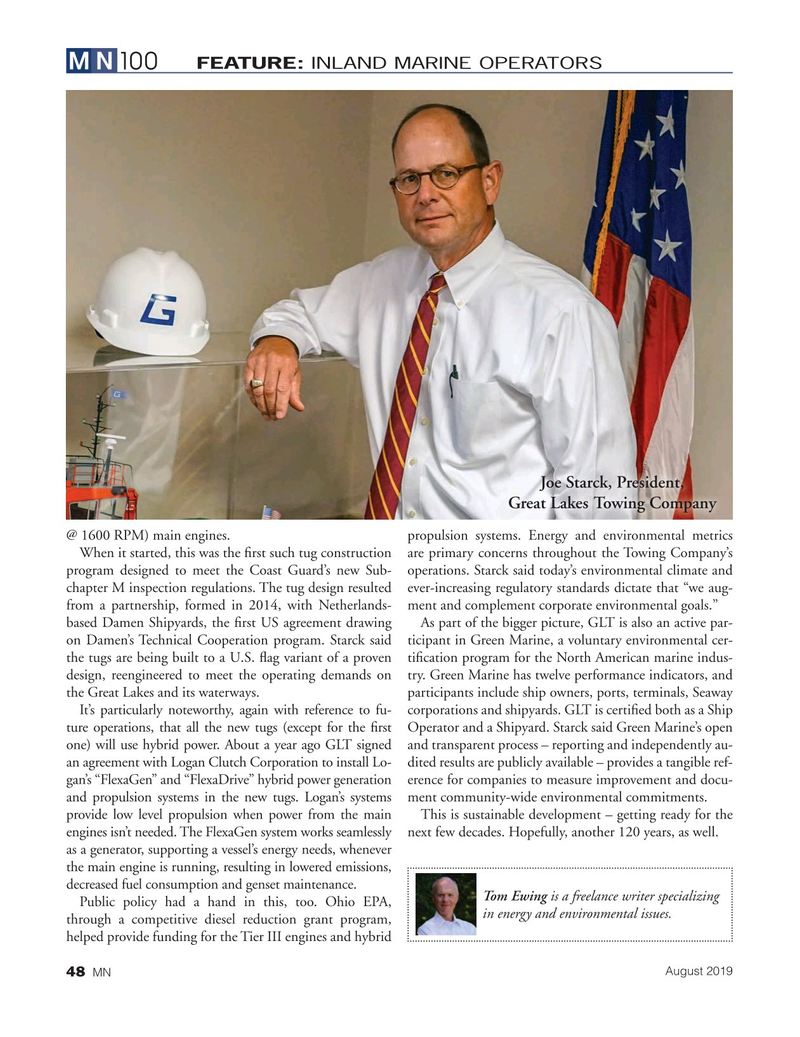
Page 48: of Marine News Magazine (August 2019)
MN 100 Market Leaders
Read this page in Pdf, Flash or Html5 edition of August 2019 Marine News Magazine
FEATURE: INLAND MARINE OPERATORS
MN100
Joe Starck, President,
Great Lakes Towing Company @ 1600 RPM) main engines. propulsion systems. Energy and environmental metrics
When it started, this was the ? rst such tug construction are primary concerns throughout the Towing Company’s program designed to meet the Coast Guard’s new Sub- operations. Starck said today’s environmental climate and chapter M inspection regulations. The tug design resulted ever-increasing regulatory standards dictate that “we aug- from a partnership, formed in 2014, with Netherlands- ment and complement corporate environmental goals.” based Damen Shipyards, the ? rst US agreement drawing As part of the bigger picture, GLT is also an active par- on Damen’s Technical Cooperation program. Starck said ticipant in Green Marine, a voluntary environmental cer- the tugs are being built to a U.S. ? ag variant of a proven ti? cation program for the North American marine indus- design, reengineered to meet the operating demands on try. Green Marine has twelve performance indicators, and the Great Lakes and its waterways. participants include ship owners, ports, terminals, Seaway
It’s particularly noteworthy, again with reference to fu- corporations and shipyards. GLT is certi? ed both as a Ship ture operations, that all the new tugs (except for the ? rst Operator and a Shipyard. Starck said Green Marine’s open one) will use hybrid power. About a year ago GLT signed and transparent process – reporting and independently au- an agreement with Logan Clutch Corporation to install Lo- dited results are publicly available – provides a tangible ref- gan’s “FlexaGen” and “FlexaDrive” hybrid power generation erence for companies to measure improvement and docu- and propulsion systems in the new tugs. Logan’s systems ment community-wide environmental commitments.
provide low level propulsion when power from the main This is sustainable development – getting ready for the engines isn’t needed. The FlexaGen system works seamlessly next few decades. Hopefully, another 120 years, as well.
as a generator, supporting a vessel’s energy needs, whenever the main engine is running, resulting in lowered emissions, decreased fuel consumption and genset maintenance.
Tom Ewing is a freelance writer specializing
Public policy had a hand in this, too. Ohio EPA, in energy and environmental issues.
through a competitive diesel reduction grant program, helped provide funding for the Tier III engines and hybrid
August 2019 48 MN

 47
47

 49
49
